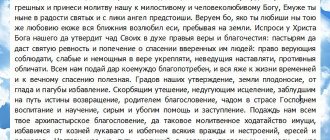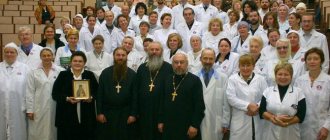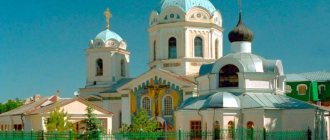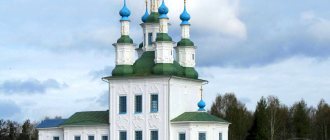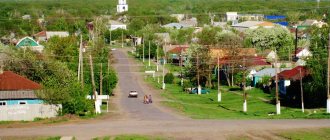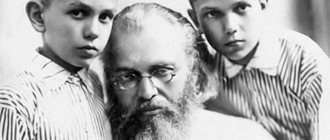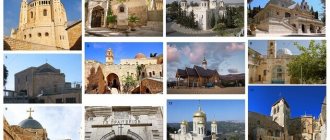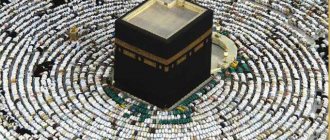To holy places. Simferopol. Saint Luke (Voino-Yasenetsky). Part 1
Audio |
60 years ago, Saint Luke Voino-Yasenetsky ended his earthly journey. About the service of the saint of God at the Crimean See, about the last years of his life and about how Simferopol said goodbye to its archpastor - in the release of the program from the peninsula. Saint Luke (Voino-Yasenetsky) was a Crimean by birth and gave more than 15 years of his life to the peninsula.
Our film crew arrived in Simferopol - the city that became the place of his preaching and earthly death. Saint Luke died on June 11, 1961, Sunday, the day of all saints who shone in the Russian land, on his tombstone there is an inscription carved: “Archbishop Luke (Voino-Yasenetsky), doctor of medicine, professor of surgery...” The archpastor was buried at the First Simferopol Cemetery, to the right of the Church of All Saints. Lyudmila Belesko, employee of the Museum of St. Luke (Voino-Yasenetsky):
“Today I decided to follow the path along which the body of Bishop Luke was carried from his house in the city of Simferopol on Kurchatov Street to this cemetery. He lived in a communal house for several families; the bishop had only two rooms. Two nieces and children lived in a large room, and he had his own room of 5 m² - this is how he lived for 15 years. He was buried on June 14. On the first day, the body was in his room, on the second day in the Annunciation Church on the first floor (this is a diocesan building), a lot of people came there for two days in a row, and on the third day, June 13, it was transferred to the Holy Trinity Cathedral. And people will be going there all day long - they came from all the nearby regions.
Now the relics of St. Luke are in the Holy Trinity Church, but then they were carried to the Church of All Saints. During the life of Saint and Confessor Luke (Voino-Yasenetsky), this cemetery church was a testing ground for the knowledge of both newly initiated and clergymen of the Crimean diocese who arrived from other regions.
Lyudmila Belesko:
– Of course, it was very difficult for Vladyka to serve, because at that time (in 1946) there were still many unworthy priests, as he believed. Saint Luke was very strict in everything, he needed only worthy priests who had to observe the Charter and canons. He was like that not only in the canons and regulations, he was just as strict in surgery.
But the authorities wanted to ban the funeral procession; they did not leave the saint either during his life or after his death.
Lyudmila Belesko:
– He was under surveillance – he was in prison and exile for 11 years; and for 15 years his every step was tracked here in Crimea. They wanted to conduct the funeral completely secretly from people. The bishop had four children, they were called and told that there would not be a terrible crowd of people. The children agreed, they needed to bury their father, but it didn’t work out quickly. The funeral began - the removal of the body from the Holy Trinity Cathedral. There were a lot of adventures during this trip, women even lay down under the bus, just so that it wouldn’t take a wrong turn... It happened: six women stood at the bumper of a GAZ-51 bus (this is a bus with a motor in front), the temperature was 30 degrees, and they walked in small steps and held the bumper)… You can walk there in half an hour, but they walked for about four hours.
Despite the authorities' ban, the entire city accompanied him - the streets were jammed, absolutely all traffic stopped right up to the cemetery; the path was strewn with roses.
Lyudmila Belesko:
“They carried it straight to the temple; the grave had already been prepared. This temple was the only one in Crimea before the arrival of the invaders in 1941, it was never closed, so you can see for yourself how many such graves there are. As soon as the bishop was carried away, the bells immediately rang here, women walked and sang all the way with the sound of the bells: “Holy God, Holy Mighty, Holy Immortal, have mercy on us.” The KGB officers kept asking: “Stop singing! Stop singing! But people sang and said: “We are burying our archbishop.”
Currently, his relatives are also trying to preserve the memory of the saint.
Lyudmila Belesko:
– He had four children - all unique, talented, all doctors of medical sciences. The children lived and were raised without a mother (at the age of 38, Valentin Feliksovich Voino-Yasenetsky’s wife died of tuberculosis), they were raised by his surgical sister (she would only be a nanny and teacher). Six great-grandchildren are now living.
In Simferopol, the archpastor lived with members of his family.
Lyudmila Belesko:
– We are now in the chapel in honor of St. Luke of Crimea. This chapel is in the house in which Vladyka lived for all 15 years, from 1946 to the day of his death. Here you can see not only the chapel, but also the door through which he entered. On the site of this chapel at that time there was the Church of the Annunciation, and the building once belonged to a convent, which is now a men's monastery and is located in the Alushta nature reserve. We believe that he came here already blind in one eye and with diabetes - already a frail man after 11 years of prison and exile.
They settled him on the second floor in two rooms. One large - 25 m², and the second - 5 m² (this is either his cell or his bedroom, we don’t know), in this room there was one narrow bed, a chest or wardrobe for things, a washstand on the wall. A year later, two nieces with their children would come to him; forty-six and forty-seven were the hungriest years; the nieces were starving because their parents (the bishop’s brothers) were shot. Evgenia Pavlovna Leikfeld, his secretary, was also like a member of the family; when he goes blind, she will be by his side. Vera Vladimirovna, the daughter of his older brother, looked after him for all 15 years - she cooked, and fed, and washed, and cleaned, and she had a blessing (as she said, “from her uncle”) to feed the poor. Maya Dmitrievna, the daughter of Vera Vladimirovna, the great-niece of Vladyka, is still alive, she said that Vladyka Luka forced the children to go and collect these beggars and bring them here. Vera Vladimirovna cooked soup and fed 20 people every day. They say they lived on this staircase and ate morning and evening.
Arriving in Simferopol in May 1946, the bishop felt the weight of the post-war devastation - a lot of work fell on the shoulders of the 70-year-old man. The churches are destroyed, the people are in poverty, there are not enough priests, but even in these difficult conditions the saint carefully ensured that the priests performed the services and sacraments correctly, he condemned greed and violation of discipline by the clergy.
Lyudmila Belesko:
“Vladyka Luka was very strict; in a year and a half he would remove about 15 priests from the diocese. Of course, at that time in our diocese it was very difficult with clergy, many came to serve simply - they came from the army, there was no work or something else... But the bishop needed worthy ones. They say that after a year and a half he had already recruited decent ones.
But, despite his advanced age and illness, Archbishop Luke restores order in the diocese, although the local authorities were not immediately happy about the arrival of the renowned archbishop-surgeon.
Lyudmila Belesko:
– The times were cruel, already in 1948 the commissioners began to cunningly close churches, they probably had their own plans... Vladyka, our fighter, would fight for every church, write to all authorities, it was very difficult for him, especially since he was already almost weak. In the 50s, he was very much asked to write a book “Essays on Purulent Surgery” (including antibiotics), the children asked their father not to take on this matter, because diabetes could lead to blindness. But it is necessary - that means it is necessary. The book was published in 1956, 30,000 copies were released, everything was sold out within a month, the whole world read it. They say that the author himself has seen almost nothing. Complete blindness began in 1958; for four years he served completely blind.
At the age of 84, 60 years ago, Valentin Feliksovich (St. Luke) Voino-Yasenetsky completed a difficult and difficult, but honest journey of life.
Lyudmila Belesko:
“They say he died calmly, did not complain, although he was completely weak after 11 years of prison and exile. There was no healthy place for him - everything was destroyed. The last time he was in the temple was on May 22, the day of St. Nicholas the Wonderworker, and then he did not enter the temple again. They say that at this time he was already feeling unwell, lying more often, not eating anything, and two weeks before his death he was already bedridden. They said that a saint had died. Someone said that he healed him, someone said that he helped him with a word - tears were constantly flowing. The KGB officers called the children and asked them to allow the body to be quickly transported. But it didn’t work out - they sang all the time. And during his lifetime, Vladyka was very worried: “Will you sing to me “Holy God, Holy Mighty, Holy Immortal”?” It turns out they sang, everything turned out right.
The second part of the program “To the Holy Places” from Simferopol will be about how the relics of St. Luke of Crimea were found, and about the Holy Trinity Convent.
Author and presenter of the program Nadezhda Kalinina
Recorded by Elena Churina
Myth and truth
In Soviet times, a strange rumor circulated around the country about a priest-surgeon who read prayers before operations. They said he was a master at using a scalpel and could cure any ailment. Moreover, the surgeon-priest wore general's shoulder straps, and during the Great Patriotic War he was in charge of a Siberian hospital.
The first claimed that the mysterious doctor lived in Siberia. The second ones are in Crimea. Still others assured - in Tashkent. The most common story about Voino-Yasenetsky said: he became a monk after the death of his beloved wife. Truth is often fused with myths, and historical facts with legends.
Only in the late 80s did the portrait of St. Luke, from whose books more than one generation of Soviet surgeons studied, begin to become clearer. And it turned out that there is not so much fiction in his biography: Voino-Yasenetsky is by no means a mythical character, but a very real person. However, he is an extraordinary person, with an unbending character, and most importantly, he has combined the incompatible.
Every Soviet person “knew”: science and religion are compatible. The priest-surgeon proved that these two spheres can coexist.
Failed artist
The Voino-Yasenetskys are an old noble family, whose representatives at different times owned vast estates in Poland and Western Ukraine. True, by the beginning of the 17th century they had become considerably smaller, and by the middle of the 19th century many of them had become frankly impoverished. Including Archbishop Luke’s great-grandfather, who ran the mill and wore bast shoes.
His father was a Catholic, an honest, kind man and an unsuccessful pharmacist. My mother was passionate about charity work, but did not attend church on principle.
Valentin Voino-Yasenetsky was born in 1877 in Kerch. A few years later the family moved to Kyiv. In addition to Valentin, the noble pharmacist had two sons and three daughters.
Voino-Yasenetsky was different from his brothers: he was withdrawn and silent. He was tormented by moral questions.
Infected with Tolstoy's ideas, he became a vegetarian, began sleeping on the floor and communicating with men. When the future bishop came across the book “What Is My Faith,” he became disillusioned with Tolstoy and never read the works of the heretic writer again. However, the hereditary nobleman was still tormented by what tormented hundreds of Russian intellectuals - guilt in front of a simple peasant.
Valentin Voino-Yasenetsky has been interested in painting since childhood. I dreamed of becoming an artist. He usually painted beggars, village women with children, earnestly praying men and wanderers with staves. After graduating from high school, the man whom Russia knows today as St. Luke wanted to enter the Academy of Arts. However, during the exam I changed my mind.
In the autobiographical book of Saint Luke it is said:
... I had no right to do what I liked, and had to do what was useful for those suffering ...
Surgeon Priest
Voino-Yasenetsky hardly sought solace in religion - he received and operated on patients 16 hours a day. But one day, two years after the death of his wife, he showed up to work in a priest’s cassock. This was in February 1921 and caused shock among colleagues.
To put on a cassock at a time when there are posters everywhere about our worst enemies - landowners, priests and white officers! And it became clear to everyone that Voino-Yasenetsky would be arrested very soon.
And again the legend about the surgeon-priest.
In his free time from operations, he spent in the church, painting icons. Somehow the workers climbed onto the roof to break crosses. Then Voino-Yasenetsky came out and began to scold them. One of the workers was standing at the top of the stairs at that moment, and when the formidable priest pushed her in a rage, he fell and broke his leg.
Voino-Yasenetsky called the orderlies, ordered them to take the poor fellow to the hospital, and there he performed an operation. Then he took off his robe, washed his hands and went to the police (“Arrest me!”).
In fact, Voino-Yasenetsky did not go to the police to surrender - they came for him when he was undergoing surgery. Moreover, this would be the second arrest, the first happened before the family tragedy and in some way brought Anna’s death closer. But both the first and second arrests did not lead to prison. Two months later, surgeon Voino-Yasenetsky was released.
War
There is such a version. During the war, Stalin summoned Burdenko and asked what he needed for normal work. Chief military surgeon answer: “Voino-Yasenetsky.” A few days later he was free.
Whether this was so is unknown. But during the war, Archbishop Luke was actually entrusted with the management of several Siberian hospitals. Moreover: Stalin awarded him the rank of major general. At the same time, Voino-Yasenetsky’s conditions were met: he did not take off his cassock and performed divine services. The priest-surgeon in general's uniform was remembered for the rest of his life by the soldiers of the Red Army.
Zemsky doctor
Having abandoned painting, Voino-Yasenetsky entered the Faculty of Law, but did not study there for long. Transferred to medical school. I hated chemistry and physics, but studied well.
Voino-Yasenetsky was an inconspicuous student: he did not take part in the public life of the university, and did not write any outstanding works. Nothing in him betrayed a future scientist, much less a preacher.
In 1903, after graduating from the university, he surprised his comrades a lot by declaring that he was going to become a simple zemstvo doctor. Not to engage in practice, not to write scientific papers, but to go into the wilderness to live in poverty and receive 50-60 village men and women a day...
In his book, Saint Luke confessed:
... I studied at the Faculty of Medicine solely to become a peasant doctor...
However, he went into the wilderness only after the Japanese War. And before that he served in the Red Cross, where he met his future wife.
